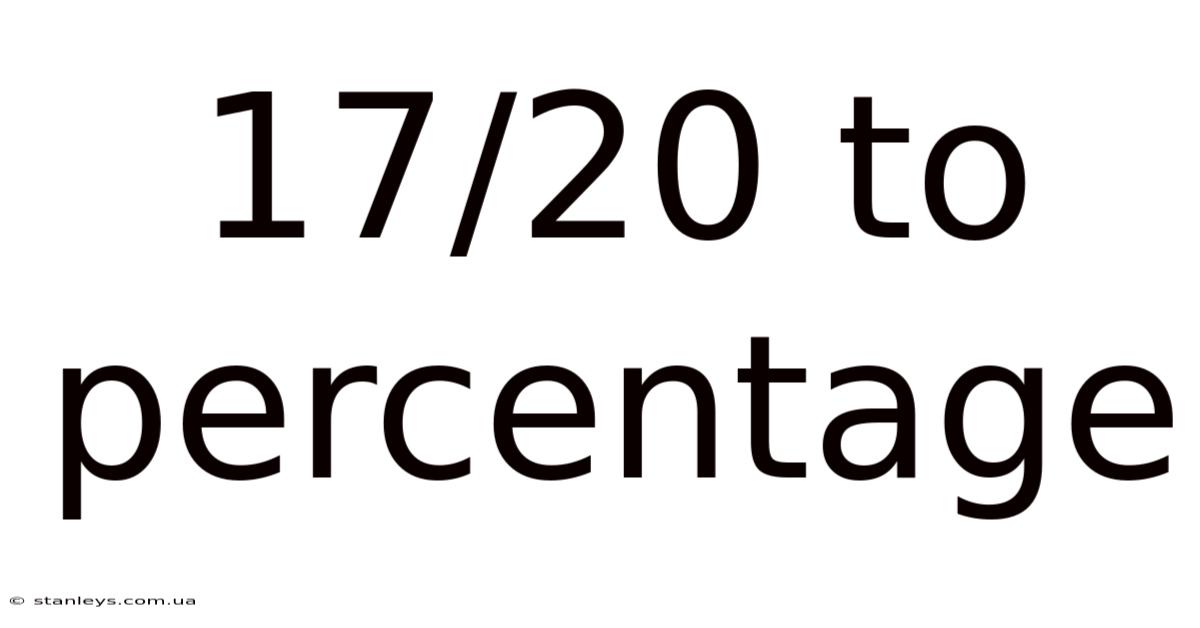17/20 To Percentage
stanleys
Sep 12, 2025 · 4 min read

Table of Contents
Converting 17/20 to a Percentage: A Comprehensive Guide
Understanding how to convert fractions to percentages is a fundamental skill in mathematics with applications spanning various fields, from calculating grades to analyzing financial data. This comprehensive guide will walk you through the process of converting the fraction 17/20 to a percentage, explaining the underlying principles and offering additional insights to enhance your understanding of percentage calculations. This guide is perfect for students, educators, and anyone looking to solidify their grasp of this essential mathematical concept. We'll explore different methods, address common misconceptions, and delve into the practical applications of this conversion.
Understanding Fractions and Percentages
Before diving into the conversion, let's briefly review the concepts of fractions and percentages. A fraction represents a part of a whole, expressed as a ratio of two numbers – the numerator (top number) and the denominator (bottom number). In our case, 17/20 means 17 parts out of a total of 20 parts.
A percentage, on the other hand, represents a proportion out of 100. The symbol "%" denotes percentage. So, 50% means 50 out of 100, or 50/100. Converting a fraction to a percentage essentially involves expressing the fraction as a proportion out of 100.
Method 1: Direct Conversion Using Division
The most straightforward method to convert 17/20 to a percentage involves dividing the numerator (17) by the denominator (20) and then multiplying the result by 100.
-
Divide the numerator by the denominator: 17 ÷ 20 = 0.85
-
Multiply the result by 100: 0.85 × 100 = 85
Therefore, 17/20 is equal to 85%.
Method 2: Finding an Equivalent Fraction with a Denominator of 100
This method involves finding an equivalent fraction to 17/20 where the denominator is 100. This makes the conversion to a percentage simpler. To achieve this, we need to determine what number we multiply the denominator (20) by to get 100.
-
Find the scaling factor: 100 ÷ 20 = 5
-
Multiply both the numerator and the denominator by the scaling factor: (17 × 5) / (20 × 5) = 85/100
Since 85/100 represents 85 parts out of 100, it is equivalent to 85%.
Method 3: Using Proportions
This method utilizes the concept of proportions to solve for the percentage. We can set up a proportion where x represents the percentage we're trying to find:
17/20 = x/100
To solve for x, we can cross-multiply:
20x = 1700
x = 1700 ÷ 20
x = 85
Therefore, 17/20 is equal to 85%.
Illustrative Examples: Practical Applications
Let's explore some real-world scenarios where converting 17/20 to a percentage would be useful:
-
Academic Performance: If a student answered 17 out of 20 questions correctly on a test, their score would be 85%. This is a common application of percentage calculations in education.
-
Sales Targets: If a salesperson aimed to make 20 sales and achieved 17, their success rate would be 85%. This helps in analyzing sales performance and identifying areas for improvement.
-
Survey Results: If 17 out of 20 respondents in a survey agreed with a particular statement, the percentage agreement would be 85%. This is crucial for understanding public opinion and market research.
-
Quality Control: In manufacturing, if 17 out of 20 products pass quality checks, the pass rate is 85%. This information helps identify potential issues in the production process and maintain high quality standards.
Addressing Common Misconceptions
Several common misconceptions surround percentage calculations. It's crucial to clarify these to ensure accurate conversions:
-
Confusing percentages with fractions: While percentages and fractions are related, they are not interchangeable. A percentage is always a fraction with a denominator of 100.
-
Incorrect multiplication or division: Ensure you're multiplying by 100 after dividing the numerator by the denominator, not before.
-
Rounding errors: When dealing with decimal values, appropriate rounding techniques should be used to maintain accuracy.
Frequently Asked Questions (FAQ)
Q: Can I convert any fraction to a percentage using these methods?
A: Yes, these methods work for any fraction. The only difference is the specific numbers used in the calculations.
Q: What if the fraction results in a repeating decimal?
A: If you encounter a repeating decimal, you can round it to a suitable number of decimal places based on the required level of accuracy.
Q: Are there other methods for converting fractions to percentages?
A: While these are the most common and straightforward methods, other approaches exist, such as using a calculator with a percentage function.
Conclusion: Mastering Percentage Conversions
Converting fractions to percentages is a fundamental mathematical skill applicable in numerous situations. Understanding the underlying principles and employing the methods outlined above will enable you to confidently convert fractions like 17/20 to their percentage equivalent (85%). By practicing these methods and understanding the practical applications, you'll strengthen your mathematical skills and be better equipped to tackle real-world problems involving proportions and percentages. Remember to always double-check your calculations and consider the context of the problem to ensure accuracy and meaningful interpretation of the results. This ability to convert fractions to percentages empowers you to analyze data, interpret results, and make informed decisions in a variety of settings. The ability to confidently perform these calculations is a valuable asset in both academic and professional contexts.
Latest Posts
Latest Posts
-
Victorian Era Cosmetics
Sep 12, 2025
-
Anti Bumping Granules
Sep 12, 2025
-
Cool Runnings Quotes
Sep 12, 2025
-
How Your Today
Sep 12, 2025
-
Micrometers To Centimeters
Sep 12, 2025
Related Post
Thank you for visiting our website which covers about 17/20 To Percentage . We hope the information provided has been useful to you. Feel free to contact us if you have any questions or need further assistance. See you next time and don't miss to bookmark.